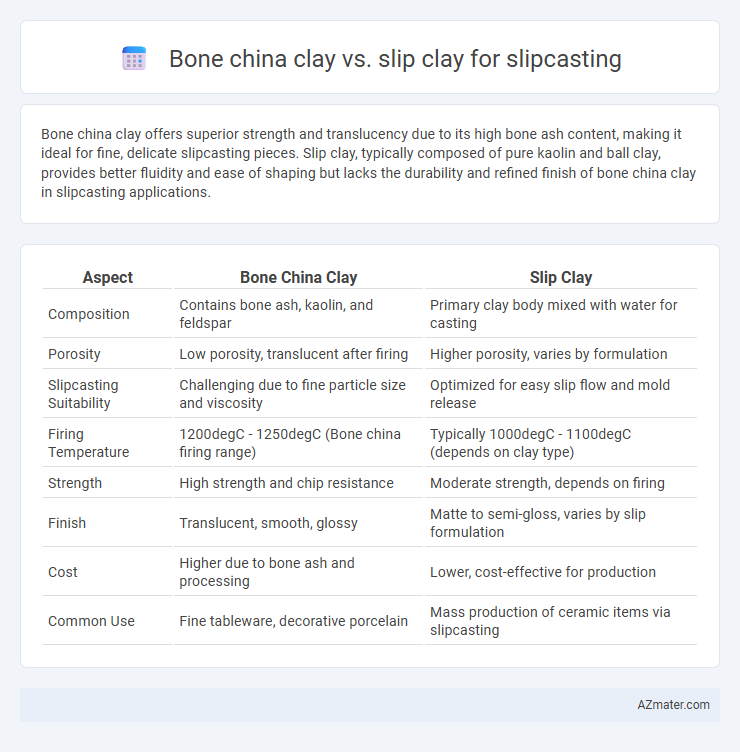Bone china clay offers superior strength and translucency due to its high bone ash content, making it ideal for fine, delicate slipcasting pieces. Slip clay, typically composed of pure kaolin and ball clay, provides better fluidity and ease of shaping but lacks the durability and refined finish of bone china clay in slipcasting applications.
Table of Comparison
| Aspect | Bone China Clay | Slip Clay |
|---|---|---|
| Composition | Contains bone ash, kaolin, and feldspar | Primary clay body mixed with water for casting |
| Porosity | Low porosity, translucent after firing | Higher porosity, varies by formulation |
| Slipcasting Suitability | Challenging due to fine particle size and viscosity | Optimized for easy slip flow and mold release |
| Firing Temperature | 1200degC - 1250degC (Bone china firing range) | Typically 1000degC - 1100degC (depends on clay type) |
| Strength | High strength and chip resistance | Moderate strength, depends on firing |
| Finish | Translucent, smooth, glossy | Matte to semi-gloss, varies by slip formulation |
| Cost | Higher due to bone ash and processing | Lower, cost-effective for production |
| Common Use | Fine tableware, decorative porcelain | Mass production of ceramic items via slipcasting |
Understanding Bone China Clay
Bone China clay is a refined ceramic material composed primarily of bone ash, kaolin, and feldspar, offering exceptional whiteness, translucency, and strength ideal for high-quality slipcasting. This clay type provides superior plasticity and smoothness, enabling detailed molds and fine surface finishes essential in delicate bone china production. Understanding Bone China clay's unique blend ensures improved casting performance, reduced shrinkage, and enhanced durability compared to Slip clay formulations.
What is Slip Clay?
Slip clay is a liquid mixture of clay and water used in slipcasting, allowing it to be poured into molds for creating detailed ceramic shapes. Bone china clay slip specifically contains bone ash, kaolin, and feldspar, offering enhanced translucency and strength compared to traditional slip clay made primarily from kaolin and ball clay. The high plasticity and fine particle size in bone china slip result in superior surface quality and durability after firing.
Composition Differences
Bone china clay contains a high percentage of bone ash, typically around 25-50%, combined with kaolin and feldspar, giving it superior whiteness, translucency, and strength after firing. Slip clay used for slipcasting mainly consists of kaolin, ball clay, and feldspar, with minimal to no bone ash, resulting in a more plastic, easily molded slurry but less translucency and strength compared to bone china. The presence of bone ash in bone china slip significantly affects its rheology, drying behavior, and fired properties, making it ideal for fine detailed, translucent ware, whereas traditional slip clay focuses on ease of casting and drying consistency.
Workability and Handling
Bone china clay offers superior workability for slipcasting due to its fine particle size and excellent plasticity, allowing for smooth and consistent pouring into molds. Slip clay typically has higher water content and lower plasticity, which can lead to less precise mold filling and increased risk of defects during drying. Handling bone china slip is generally easier as it maintains a stable consistency, reducing the need for constant remixing and minimizing air bubbles during casting.
Firing Temperatures Compared
Bone china clay typically requires higher firing temperatures ranging from 1200degC to 1300degC to achieve its characteristic translucency and strength, whereas slip clay used for slipcasting generally fires at lower temperatures, around 1000degC to 1150degC. The higher firing temperature of bone china clay results in greater vitrification and durability, making it ideal for fine china and delicate tableware. Conversely, slip clay's lower firing point allows for easier shaping and faster production but may yield less strength and translucency compared to bone china.
Strength and Durability
Bone china clay offers superior strength and durability in slipcasting due to its high bone ash content, which enhances translucency and impact resistance. Slip clay, typically composed of kaolin, ball clay, and feldspar, provides good plasticity but generally lacks the long-term durability and mechanical strength of bone china. Consequently, bone china clay is preferred for fine, resilient ceramic products requiring enhanced structural integrity.
Surface Finish and Appearance
Bone china clay offers a smooth, translucent surface finish with a delicate, refined appearance ideal for high-quality slipcasting pieces. Slip clay, often denser and less translucent, results in a more opaque, matte surface that may require additional finishing for a polished look. The choice between bone china clay and slip clay directly impacts the final texture and visual finesse of slipcast ceramics.
Porosity and Water Absorption
Bone china clay exhibits lower porosity and reduced water absorption compared to slip clay, resulting in a denser and more durable ceramic body. Slip clay, typically more porous, allows for higher water absorption during slipcasting, which influences drying times and surface finish quality. Understanding these differences is crucial for optimizing mold release and achieving the desired strength and translucency in slipcast ceramics.
Cost Considerations
Bone china clay typically incurs higher raw material and production costs compared to slip clay, reflecting its refined composition and enhanced translucency. Slip clay used in slipcasting offers more economical pricing, making it suitable for large-scale or budget-conscious pottery projects. Cost considerations must balance the desired quality and finish against material expenses and processing time.
Best Applications for Each Clay Type
Bone china clay offers exceptional translucency and strength, making it ideal for fine tableware and decorative pieces requiring delicate finishes in slipcasting. Slip clay, characterized by its higher plasticity and ease of shaping, excels in producing larger, more intricate molds and sculptural forms due to its superior mold release properties. Selecting bone china clay suits projects emphasizing translucency and mechanical strength, while slip clay is best for complex shapes and efficient mold separation in slipcast ceramics.

Infographic: Bone china clay vs Slip clay for Slipcasting
 azmater.com
azmater.com